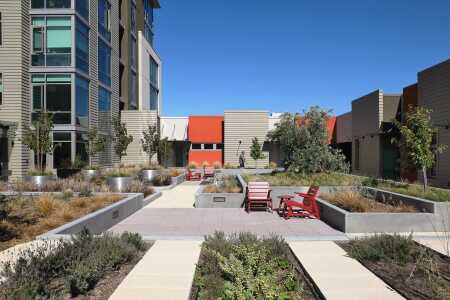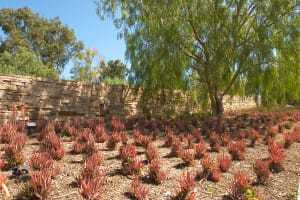
One of the innovative water management strategies in California is water reuse. San Francisco’s new 38 Dolores multifamily project, designed by BAR Architects, includes a landscaped terrace with raised planter beds of native, drought-resistant plants. Water that hits this level flows through beddings and is captured by a subsurface drainage system and reused for irrigating the overall site. (BAR Architects)
The current severe drought in California is stretching into its fourth year, with the first three years being the driest consecutive years in the state’s history. This situation has triggered unprecedented state and local policies to curtail water use, and one of the most affected industries is real estate. After all, 20 percent of all water used in California comes out of faucets, hoses, and other taps inside and outside residential and commercial properties, according to industry estimates. As a result, some real estate developers and builders are becoming more innovative and technologically advanced in their water planning.
Consider homebuilder KB Home. In its new subdivision called Sea Cliff in San Diego, each of the 52 homes will feature a residential graywater system, which recycles water from sinks, showers, and washing machines to use for outdoor watering. It is believed to be the first such system that is a standard feature in a new development.
The $10,000 system routes water from drains and pipes to a 50-gallon (189 liters) underground tank, then runs that water through a filtration system that removes virtually all bacteria and impurities but does not render the water drinkable. The filtered water gets stored in a 200-gallon (757 liters) underground tank that feeds a home’s landscaping system. It is expected to reduce residential water use by more than 50 percent.
“Some builders are telling us it may almost be a requirement now to do water recycling,” says Ralph Petroff, chairman of Nexus eWater, a California water technology company that created Sea Cliff’s system. “It has the potential to radically change the way we use water.”

A new residential development in San Diego called Sea Cliff is believed to be the first in the country to include a water recycling system as a standard feature with the new homes. The system, developed by California-based Nexus eWater, collects gently used water from sinks, showers, and appliances; treats it for most impurities in the boxlike structure on the side of homes; and then that recycled water is stored in an underground tank for use in outdoor irrigation and for flushing. (Nexus eWater)
The drought is not yet slowing new housing development throughout California, but it is changing how some developers approach water use and conservation. In particular, because previous state policies have succeeded in reducing indoor water use, the new frontier in water conservation innovations is focusing on the outdoors. Some of the advancements that require design modifications on properties include the following: irrigation systems that drip water rather than spray it; rainwater collection systems; and graywater recycling systems.
“We’re definitely moving in a direction in which water is increasingly a consideration in new development,” says Adrian Covert, a policy director at the Bay Area Council, a business-sponsored public policy advocacy group. “There’s a great opportunity with new housing to use the newest water-saving technologies.”
Stephen Smiley, a senior vice president in the San Francisco Bay area for housing industry consultant Meyers Research, foresees potential opportunities for some real estate companies that adapt to the new realities of drought. “Builders are going to have to be proactive, and I think some will use water efficiency to their advantage and promote that advantage,” he says. “Some are going to develop a competitive edge.”
“Don’t Stop People from Coming”
A drought, strictly defined, is a period of lower-than-normal rainfall and climate conditions that result in water-related scarcity. California officially experiences drought conditions once every decade or so, for a total of seven times in the past 100 years. But the current drought is already considered one of the most severe ever recorded, with rainfall levels below those seen in past droughts, groundwater supplies being depleted, and no end in sight. The state’s official 2015 measurement of the Sierra Mountains snowpack—the runoff from which provides about one-third of the water used by California’s cities and farms—found the lowest recorded level since 1950.
In January 2014, Governor Jerry Brown declared a state of emergency and called upon Californians to voluntarily reduce their water consumption by 20 percent. After limited progress toward that target and with no letup in the drought, the governor issued an executive order in April 2015 requiring the state water board to impose restrictions to achieve a 25 percent reduction in tap or drinking water in just two years. The resulting restrictions range from 8 percent reductions for some already eco-conscious cities, up to 36 percent for the state’s highest per-capita water users in some affluent suburbs such as Beverly Hills and some spread-out suburbs such as Hemet, which is outside the city of Riverside.
Despite the water crisis, California’s real estate markets are on a tear.
On the commercial side, the state has some of the nation’s lowest office vacancy rates, and office and industrial rents are going up so fast that any extra water-related expenses—such as possible water rate increases—can be passed on to tenants. “The market is robust enough to absorb those costs,” says Steve Grant, managing principal of San Francisco–based investment advisory firm Property Recovery Advisors and chair of ULI’s Industrial and Office Park Development Council (Black Flight).
Likewise, on the residential side, new-home construction is surging this year. Combined single-family and multifamily permits in the state through May were up 20 percent over last year, double the national growth rate, according to the National Association of Home Builders. Some of California’s larger metro areas, such as San Francisco/Oakland and San Diego, have experienced more than 30 percent increases in new-housing permits this year.
The primary reason why the drought is not drying up housing construction is simple: California has an acute housing shortage that is attributable to its ever-growing population. The state Legislative Analyst’s Office, in a report earlier this year, concluded that California needed to build three times as much housing as it did from 1980 through 2010 just to keep its home prices in line with those in the rest of the country. Instead, the lack of supply has led to a median home price that is two-and-a-half times the national average.
More homebuilding may even help water conservation efforts. Today’s new homes are much more water-efficient than older homes. After the last drought, which happened in the late 2000s, the 2011 California Green Building Standards Code, known as CALGreen, set new maximum-flow rates for showers, toilets, and other plumbing fixtures in new construction. As a result of this and previous state and national policies, it is estimated that a typical California three-bedroom single-family house built in 2013 uses half as much water indoors as a similar house built in 1975, and it uses 21 percent less water indoors than the same house built right before CALGreen was implemented, according to California-based energy consultant ConSol.

International landscape firm SWA Group has dealt with California’s drought in new real estate developments by incorporating more drought-resistant plants, spacing out plantings so that they require less water, and preserving natural topography when possible. In the 2,000-acre (800 ha) Shady Canyon development in Irvine, SWA’s concept was to use native shrubs for the basic landscape palette and minimize grading so that the project preserved the site’s rural character. (SWA)
“You can’t pull the plug on growth every time there’s a drought,” says Tim Quinn, executive director of the Association of California Water Agencies, a coalition of the state’s water districts. “You don’t stop people from coming and you don’t stop people from building. You just have to maintain the quality of life with less water.”
Of course, California is working on ways to maintain the quality of life there with more water. Several desalination projects—which turn ocean water into drinking water—are in the works, and state voters last year approved a monumental $7.5 billion water bond issue to build new reservoirs and other infrastructure. But those are longer-term solutions. So in the short term, some communities and water districts have raised the prospect of slowing or even stopping new housing development to ease pressure on the water supply.
Last fall, the State Water Resources Control Board ordered 22 small water districts in northern California to impose a temporary moratorium on new water connections. In recent months, other cities including Petaluma outside the Bay Area, Pismo Beach in the state’s central coastal area, and Ventura in suburban Los Angeles have discussed, but did not adopt, residential building moratoriums. But the Bay Area suburb of Pleasanton this past spring did suspend planning for an old quarry site where developers want to build 1,300 new homes.
Dave Cogdill, president of the California Building Industry Association, calls moratorium discussions an unfortunate “knee-jerk reaction” to the drought. But he acknowledges that “if we go through another year like this, [possible moratoriums] will likely become more of a challenge.”
Creative Landscaping
Rather than pursuing moratoriums, most communities and water districts are simply establishing new conservation policies and standards. This past June, San Francisco passed a landmark ordinance mandating the inclusion of water recycling systems inside new buildings larger than 250,000 square feet (23,000 sq m). But most new regulations are aimed at outdoor water use. After all, watering grass and landscaping can be inefficient—sprinklers can soak sidewalks and driveways, and there is no gauge to tell when enough water has been applied. “The biggest untapped source of conservation is outdoor landscaping,” says Peter Gleick, president of the Pacific Institute, an independent environmental research and policy center based in the San Francisco Bay area.
This is literally changing the look of real estate properties. Some regional water districts and municipalities are offering rebates for removing lawns—programs known as “cash for grass”—such as $2 per square foot up to 3,000 square feet ($22 per sq m up to 280 sq m). Earlier in the year, the Sacramento suburbs of Woodland and Roseville went a step further, instituting a ban on grass sod landscaping for new homes. And in July, the California Water Commission, which oversees some state water spending, adopted regulations to limit “high water use” landscape elements such as turf grass to just 25 percent of a home’s landscape area, and it effectively banned grass around new commercial and public developments.
As a result, a burgeoning business is emerging for replacing residential lawns with xeriscaping and rock gardens, and landscape designers for new developments are becoming more creative. In Menlo Park, a suburban community in the Bay Area, international landscape architecture firm SWA Group was in the midst of preparing designs for a 16-acre (6.5 ha) hotel/office complex called Menlo Gateway when the city council adopted new water restrictions this year. Combined with new state mandates, these city rules restrict the use of the local water supply for irrigation or ornamental fountains. SWA then prepared a design that combines a drought-tolerant Mediterranean plant palette with rock mulch and permeable paving, along with soil mixes that maximize water retention and encourage deep-rooted plants.
“As designers, we will need to choose plants that are specifically tailored to a drier California landscape,” says Elizabeth Shreeve, a principal in a Bay Area office of SWA and an assistant chair of ULI’s Sustainable Development Council. “These sorts of challenges are what’s ahead for us.”
Emerging Technologies
Overall, a host of advanced technologies, mostly developed by startup companies, is emerging or growing to help existing and new real estate developments use less water. Some of the ideas gaining traction include the following:
- Water-monitoring devices. These include water-consumption monitors, smart outdoor-watering management programs, and kits to convert old-fashioned water meters into smart meters. For example, one of San Diego’s largest new master-planned communities, Civita, is outfitting each new home with a display monitor, mounted next to the thermostat, which provides digital readouts of water use.
- Graywater recycling systems. Like the system used at Sea Cliff in San Diego, these collect used water from a home’s bathroom drains (excluding toilets) and home appliances and then treat the water and recirculate it to sprinklers. Some systems can recirculate the treated water for toilet flushing as well. In San Francisco, graywater recycling is expected to become the system of choice to meet the new water recycling mandate for large buildings.
- Rainwater collection systems. These capture runoff from drains and pipes and collect the water in an underground cistern for reuse. BAR Architects designed a rooftop collection system at the new 38 Dolores project of multifamily units built above a Whole Foods Market in San Francisco’s Upper Market neighborhood. “We’re looking at water reclamation systems on many more projects,” says David Israel, one of BAR’s principals and a vice chair of ULI’s Urban Development/Mixed-Use Council (Purple Flight). “There’s always the question from developers about the cost and whether they need this. But because of the drought, there’s a clearer understanding of why it’s so necessary.”
Still, investments in new water-saving technologies remain merely a trickle.
U.S. corporate and venture capital funding for water company startups has totaled just $1.47 billion from 2010 through the first half of 2015, according to the San Francisco–based Cleantech Group. By contrast, transportation entrepreneurs such as Tesla attracted more than $15 billion in venture funding, and solar energy drew more than $6 billion. Venture capital for water has even declined since the 2012 onset of California’s drought.
Funding experts believe this situation stems in part from a general lack of government attention. The U.S. government has not promoted water technology the way it has renewable power and green buildings, and California’s own Drought Technology Program, which intends to invest in water- and energy-saving technologies, had not, as of the summer, received funding from the state legislature.
With water technology options growing but still somewhat limited for real estate purposes, some new developments are relying on luck or old-fashioned water sources to fulfill some of their water needs.
The Cannery, a new master-planned mixed-use community being built in Davis, outside Sacramento, is one such development. Its 100 acres (41 ha) are planned to include 550 homes and a town center, along with a seven-acre (2.8 ha) working farm and a variety of public green spaces, including trails and a soccer field. In the past, the New Home Company, the developer, would not have thought twice about connecting to the local water supply to irrigate all the public spaces. But not now. The Cannery intends to water its parks, medians, and landscaping from its own supply—an on-site underground well left over from the previous use of the property, a Hunt-Wesson tomato canning facility from which the development takes its name.

With the state and some California communities imposing new restrictions on how public water supplies can be used, a new master-planned community in Davis, outside Sacramento, has the good fortune to be able to tap into its own water supply—an underground well connected to a nearby aquifer. The developer, the New Home Company, has added a well-based irrigation system to water the street landscaping and other public spaces. One of the community’s neighborhoods is the Heirloom, a collection of three-story townhouses in rowhouse designs. (The New Home Company)
The 400-foot-deep (122 m) well draws its water from a nearby aquifer, which is replenished from rainfall. This type of water use has its critics, but California is one of the few states with no restrictions on pumping water from underground, although the state is beginning to require local communities to develop more oversight of groundwater sources. At the Cannery, the well-based irrigation system costs $1.25 million, or $2,300 per home, for the additional pipes and pumping equipment. But even with this extra water source, the development is limiting its installation of grass for parks and lawns.
“The wave of the future is going to be changing the expectation in new-home construction,” says Kevin Carson, the New Home Company’s president for northern California. “When they look at new homes, most people want to landscape their front- yards with turf. But the practice is now changing, and it’s up to us in the industry to make the change desirable and marketable.”
The drought may be California’s problem right now. But it is not the only part of the country suffering from drier-than-normal conditions, and California has traditionally been a leader and trendsetter for sustainability approaches. So some of the innovations being applied in California could eventually make their way inland in coming years.
“The new movement toward green infrastructure and water conservation, that’s not going to go away,” says Charlie White, chief executive officer of Paver Guide, which was recently recognized in California as an innovative water startup for its porous liner under parking lots and sidewalks that can capture water runoff. “It’s only going to accelerate and become a national phenomenon.”
Jeffrey Spivak, a senior market analyst in suburban Kansas City, Missouri, is an award-winning writer specializing in real estate development, infrastructure, and demographic trends.









